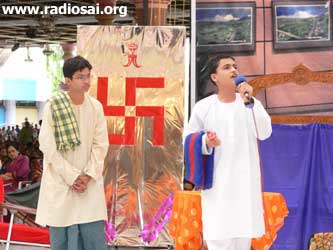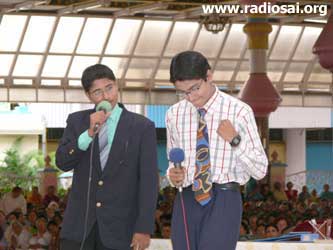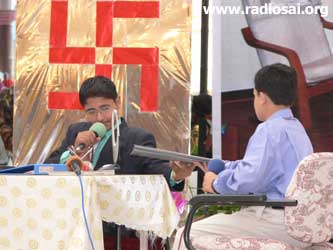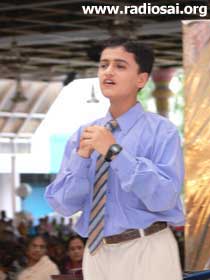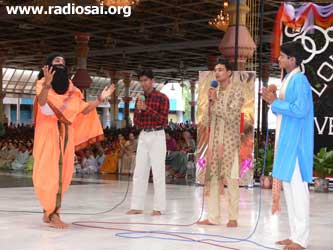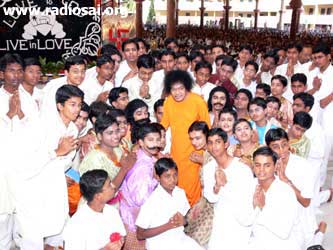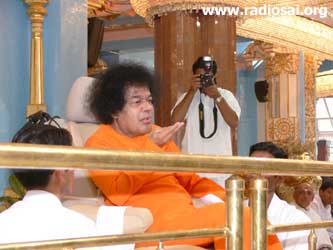PRASHANTI DIARY
CHRONICLES OF HEAVEN ON EARTH
When we ended last month’s chronicles we had described for you the Ganesha Chaturthi ceremony on August 27th where numerous clay Ganesha idols were blessed by the Lord. These idols are then worshipped for a few days (3 to 5 days) and then in a “Ganesha Immersion Ceremony” are immersed into a body of water so that the clay idols get dissolved and Lord Ganesha “returns” back home. We bring you a complete account of this impressive immersion ceremony held on August 31st in this month’s account. This past month also saw the celebration of the Onam festival of Kerala wherein about 800 Malayalis (as the people of Kerala are called) came to Sai Kulwant Hall to spend this holy day with their divine mother and father.
August 31st 2006: The Ganesha Immersion Ceremony
The idols of Lord Ganesha worshipped in schools, colleges, and the different departments of the Central Trust by the students and staff of Swami’s Institutions were brought in a procession on floats on what is called the “Ganesha Immersion Day” ceremony. There were a total of 23 floats in the procession that day. Leading them was a float by the Primary School followed by the Deenajanodharana Pathakamu (Swami’s orphanage). Occupying 3rd to 6th positions in the procession were the Ganesha floats by the staff of the General Hospital, Airport, Gokulam, the Chaitanya Jyoti Museum, and the Super Specialty Hospital. Ganesha floats of the 8th and 9th class, the 10th class and the High School main chariot followed by the Institute main chariot were next in line. The 2nd Post Graduate, 3rd Under Graduate (UG) and the 11th class floats followed by the Music College float and a clutch of school boys dressed as priests were next. In the 16th to 19th place were floats by the 1st UG boys, the 2nd UG boys, and the 1st P.G. boys and the Poorna Kumbham Group. Alumni working in Swami’s institutions (in Central Trust and Book Trust) and alumni working elsewhere but visiting Parthi for the festival were next. The last two floats were from the Mandir and the Easwaramma High School.
|
|
|
The Deenajanodharanan float entering Sai Kulwant Hall |
|
The high school Ganesha in a car |
These floats are creative affairs and are either well decorated chariots or palanquins of all shapes and sizes and colors and hues. They each have a theme with one being shaped like the marble lingam of the just concluded Ati Rudra Maha Yagna or another being shaped like the yagna kunda where two young boys dressed like priests continuously poured oblations. Some floats were made up like peacocks or butterflies while one was like an open lotus flower in which Lord Ganesha was seated. But each float was colorful and unique representing the creative effort of the group that had lovingly worked on it for days.
The whole procession was well planned and each float had a designated point from which they would join the procession as it started from the Senior Boys’ Hostel till it reached Sai Kulwant Hall. All the floats entered Sai Kulwant either from the Main Gate or from the East Gate and were directed to their respective positions in the Hall. The biggest floats got the pride of place in the middle of Sai Kulwant Hall. After all the floats were in place, Swami drove past the entire procession blessing all the students and the staff.
|
|
|
The Super Hospital float |
|
Swami driving past the floats |
After Swami reached the veranda and occupied His place on the dais, the boys from the Poorna Khumbham group brought their khumbhams (an ornate vessel with a coconut surrounded by mango leaves) to be blessed by Swami. Children from the primary school also brought handicrafts that they prepared with Lord Ganesha as the theme to show Swami. Following this the boys dressed as priests and each carrying his own Ganesha brought them to be blessed by Swami. Lord Ganesha certainly kept Swami very busy that afternoon.
|
|
|
Blessing of Poorna kuhmbams |
|
Primary school handicrafts |
After this the Institute boys put up a skit to explain the meaning of this immersion process to the crowd, some of whom were quite wide-eyed and perplexed at this rather clamorous and colorful ceremony in an otherwise normally serene and dignified Sai Kulwant Hall.
The skit started with two elders around 35 years old walking by when two children named Srineel and Ashish were creating a noise. One of the elders reprimands them to which they protest by saying that they are just enjoying their Ganesha Chaturthi holiday. This triggers off a discussion between the elders and the children on the significance of Ganesha Chaturthi. The two elders (Ram and Nikhil) then recollect their Sai student days when such a celebration was different and full of meaning. Each class used to have their own Ganesha idol nicely decorated in their hostel room for 3 days. They had their own class pundits who had learnt the mantras and used to perform puja every morning and evening for these 3 days. During this time the entire class would be enthusiastically engaged in preparing the chariots in which they would carry their Ganesha idol from the hostel to the mandir (accompanied by Veda chanting and bhajans), where Bhagavan would be eagerly waiting for them.
Inside the mandir, Bhagavan would go to each chariot and give the boys class photos with their Ganesha. Following this the boys would then go for the immersion ceremony. The skit thus not only explained to the crowd what was going on that day, but also elaborated that the inner significance of the immersion of the idol was that the seeker should start worshipping the God with form and then progress to the formless God. This skit was followed by a vigorous dance by five high school students dressed in red to round off the program.
|
|
|
A Skit on the Ganesha Immersion day |
|
The High School Dance |
The Warden then approached Swami and requested His permission for everyone to circumambulate the Prasanthi Mandir, to which He readily agreed. The nearly 1000 strong Veda chanting or bhajan singing staff and students then circumambulated the temple and occupied their respective places and waited for the rest to finish.
After the circumambulation was over (it took 20 minutes for all of them to finish), each group then brought their chariots carrying their Ganesha into the center of the Hall in front of Swami for His blessing and then took their idols out for immersion into a big pond just outside the town.
Generally, all the roads in Puttaparthi also have their own Ganeshas and after this ceremony is performed in Sai Kulwant Hall by the students and staff, these Ganeshas from different streets of Puttaparthi are also taken in procession for the immersion ceremony over the next 2-3 days before the Ganesha Chaturthi ceremony is finally over.
|
|
|
|
|
Floats being blessed before being taken away |
Sept 2nd: The 34th Anniversary Celebrations of the Central Trust
September 2nd marks the anniversary of a special day in the mission of our Lord Sai, for it was on this day, thirty-four years back, that Bhagavan founded the Sri Sathya Sai Central Trust to play an important role in His Divine mission.
Elaborating on what constitutes His task, Bhagavan Himself declared in a letter to Sri Seshama Raju Garu in the year 1947:
“Beeda Saadhalakaina Penu Baadha Tholaginchi Lemini Baapute Prema Naaku.”
“I am attached to My work – that of alleviating the sufferings of the poor and granting them what they lack.”
The Sri Sathya Sai Central Trust has been instrumental in setting up and supporting various projects of Bhagavan to this end. It has been the conduit for Bhagavan’s love to reach millions and transform their lives. |
|
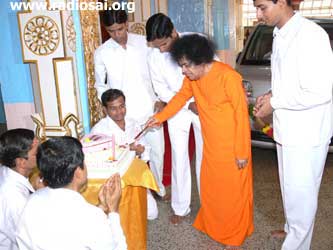 |
| |
|
Cutting the cake on arrival |
Today, nearly six decades after that historic declaration, when we see the schools, the university, the hospitals, the mammoth water supply projects, the Grama Seva programs and many other such social welfare activities, we know that that they are but the concrete materializations of His Divine will, His vision, and His words.
To mark this epochal event, the alumni of the SSSIHL working in one of Swami’s institutions – either the Central Trust or the Book Trust, the Institute or in the Hospital – arranged a special program in Sai Kulwant Hall. Swami is never one to note the anniversary of any of His projects or to publicly celebrate any of the achievements of the Institutions which bear His name. This public function was set up entirely at the initiative of the alumni working in His institutions to express their love and gratitude to Bhagavan for having bestowed upon them two very sacred boons:
1. The gift of free education in His school and university.
2. The rare opportunity of serving at His Lotus Feet.
Expressing their combined feelings, they said, “Swami, it’s due to your immense compassion and the result of our good deeds in many previous lives that we have this unique blessing. And what better way to convey our sweetest feelings to our dear Lord than through the language of melody. For is He not ‘Gaana Priya’ and ‘Gaana Lola’? [Lover of Music]”
|
|
|
Blessing the boys before the concert |
|
Showing Swami the card |
So on the afternoon of September 2nd, 14 alumni serving in the various Sai Institutions, as well as 5 current students, offered a bouquet of songs at the Divine Lotus Feet.
The boys prepared a cake that Swami graciously cut as soon as He alighted from the car. After He took His seat on the dais, all the artists took His blessings before starting the concert. A card the boys made was shown to Him before the start of the program.
|
|
|
Ravikumar sings Sai Ram Sumiran |
|
Prashanth sings Nimmu Gani Saranamani |
Great is the singing talent among Swami’s students and on this day there assembled a veritable crowd of 9 singers, 5 percussionists, 3 keyboardists, a sitar player and flutist to regale the crowd gathered there with the melodious music of 13 songs sung straight from the heart.
Sri Ravi Kumar, an alumnus currently working in the Super Specialty Hospital in Puttaparthi, set the ball rolling with his “Sai Ram Sumiran.” Sri Srinivasulu, a 1991 graduate now working in the Book Trust, sang “Dayaku Premaku” next, followed by Sri Prashanth, from the Sri Sathya Sai Bhakta Sahayak Sangh, with “Ninnu Gani Saranamani.”
Sri Ashwin, working in the Super Specialty Hospital in Whitefield, then sang “Vande Janani” with Sri Aswath Narayan, a current student, following this with his “Aanathineeyara Hara.” Ravi, Srinivaslu and Prashanth then sang the solo songs “Hey Giridhar Gopal,” “Ghanaghana Sundara,” and “Om Namah Shivaya". This was followed by Sri S. Srinivasa Rao and Sri Subhash Subramaniam with their duet, “Sumar Manuva". Current students Sri Guru Prasad and Sri Omprasad then sang in turn the solo songs “Nee Madhu Murali Gaana Leela,” and “Hey Shiva Shankar Hey Karunakar". Two well-sung, fast-paced group songs formed the finale to this beautiful concert: “Sai ke Darbar Mein,” and “Pyare Sai Hamare".
|
|
|
A full view of the concert |
|
Swami distributes clothes to all |
|
|
At the end of the concert, Swami walked over and personally distributed clothes to all the artists. He was obviously very pleased for He blessed everyone individually with a kind word, a pat on the cheek, or with His Hand placed on the head, small but tangible signs of His immense love for His students and their immense love for Him. Finally, He posed for group photographs, holding the hands of the students nearest to Him. |
The Coveted Group Photograph |
|
|
Sept 3rd to 5th: Onam Celebrations in Sai Kulwant Hall
Sama-bhavana, or the feeling of oneness between man and man, was the rhythm when Emperor Mahabali ruled his kingdom of Kerala in erstwhile days. The Keralites experienced this same sama-bhavana again when men and women of all castes and creeds, from Members of Parliament and Chief Justices of High Courts, musicians, electricians, clerks and others from all walks of life flocked to Prashanti Nilayam to celebrate Onam for three full days in the presence of our beloved Lord Sai.
Onam is basically a family oriented festival when the nuclear family that characterizes this Age of Kali gathers together at their native place in Kerala, returning home at this auspicious time to be with their kin and reestablish their roots and catch up on the times when they were away. The Kerala members of the Sai family on this day overcame their attachment to their own close relations and chose to spend this auspicious time in the presence of their divine mother and father Lord Sai and celebrate this festival with their Sai brothers and sisters not only from Kerala but from all parts of the world. While Onam is celebrated over 10 days, the Keralites came to celebrate the last three (and most important) days of this 10-day festival.
The celebration of Onam is linked to the following story of emperor Bali. Emperor Mahabali was a just ruler, fair-minded in his approach, a man of impeccable character and generous to a fault. Lord Vishnu once wanted to test His devotee and so came to the emperor’s court disguised as a dwarf (Vamana Avatar) and asked the emperor to gift Him the land that He could cover in three steps. The emperor laughed and without recognizing the divinity in the Vamana Avatar, suggested the “dwarf” ask of him something more realistic. The emperor’s preceptor however, recognized Lord Vishnu and warned the emperor about agreeing to this strange request. The emperor did not go back on his word and agreed to it. At this the dwarf began to grow and soon assumed immense proportions. With His first step He covered all the land on earth and with His next step He covered all the space in the sky. Now He had nowhere to keep the third step! At this the emperor offered his own head for the Lord’s third step.
As Swami explained in His discourse later on, the emperor had a tinge of ego that was a stain on his otherwise sterling qualities. So Lord Vishnu wanted to actually bless him by removing this trace of ego and hence took up the Vamana Avatar. What a glorious lesson for posterity and what a deeper meaning attached to the celebration of the Onam festival by the Avatar of this age! Three steps for Mahabali to learn the lessons of surrender, three days to celebrate the Onam festival in Prashanti Nilayam and immerse ourselves in the bliss of Bhagavan’s love.
|
|
|
A view of the decorated façade |
|
A closer view |
The Onam celebrations started on the evening of the 3rd after Bhagavan’s arrival at Sai Kulwant Hall to the sonorous sounds of the Veda chants. After he had taken His seat on the dais, He gave permission for the evening program to start. 33 Bal Vikas children from Calicut in Kerala performed a play for Him entitled “Bhakti and Vibhakti” – “Devotion and Grammatical Accuracy.”
This drama presented several remarkable episodes from the lives of Sri Poonthanam Nambudiri and Sri Melpathur Narayana Bhattathiri, two famous devotees who lived in the 17 th century and worshipped Lord Bala Krishna in His form as Lord Guruvayurappan at the Guruvayur temple in Kerala.
Poothanam Nambudiri, author of the popular Malayalam poem “Gnanappana,” was a simple, pious, pure hearted scholar and an ardent devotee who used to visit the Guruvayur temple which was far from his home. On one such journey he was attacked by dacoits and was saved by the Lord Himself who came in the guise of the Commander-in-Chief of the king.
|
|
|
Welcoming Bhagavan |
|
Poonthanam being attacked by dacoits |
Another innocent devotee of the Lord, a young girl named Manjula, used to offer flower garlands to adorn the idol of the Lord Guruvayur. One day, she was unable to make her offering as she was late and the temple doors were already closed. Poonthanam advised the sorrowful girl to place the garland on the stone near the banyan tree on the Eastern gate of the temple as the Lord is all-knowing and omniscient, and she did so with full faith in his words. The next day, everyone was surprised to find the very same garland adorning the idol in the sanctum sanctorum when the doors opened in the morning and the garland could not be removed till Manjula saw it.
|
|
|
Garlanding the stone |
|
The same garland adorns the Lord |
The eminent Sanskrit scholar Sri Melpathur Narayan Bhattathiri came to Guruvayur to worship the Lord to rid himself of paralysis. As per the advice given to him by Sri Thunjat Ezhuthachan, also known as Kerala’s Vysya, Melpathur started composing the “Narayaneeyam,” a Sanskrit version of the story of Lord Krishna, within 100 days. On one such day, he noticed Poonthanam chanting the Vishnu Sahasranama in a faulty way. When Sri Poonthanam chanted “Mara-Prabhu,” Sri Melpathur corrected him in a rude and imperious manner by saying “Amara-Prabhu.” Then they heard the voice of God saying “Melpathur, I am also the God of Mara, i.e., the trees.”
On the 99th day of his goal of writing the “Narayaneeyam” in 100 days, Melpathur had darshan of the Lord and realized his disease had been completely cured. He praised the mercy and beauty of the Lord.
A few days after Melpathur was cured, Sri Poonthanam, after completing his poem “Gnanappana,” approached Melpathur and requested him to correct the mistakes in the manuscript. Melpathur in his pride refused the request and said it was full of mistakes as it was written in Malayalam (and not Sanskrit) and Poonthanam felt humiliated.
|
|
|
Composing the Narayaneeyam |
|
Initially Melpathur refuses the manuscript |
The Lord did not tarry even a moment when his devotee was thus humiliated. Melpathur was again attacked by the same paralytic stroke of which he had just been cured and cried out in anguish asking the Lord for the reason.
The Lord replied that He likes pure devotion – bhakti – rather than grammatical accuracy – vibhakti. The repentant Melpathur rushed towards Poonthanam and accepted his manuscript, not just for correction but for God realization. He was immediately cured again and both devotees praised the Lord for His love towards His devotees.
|
|
|
| |
|
Melpathur humbly accepts Poonthanam’s manuscript |
The story itself was engaging and well produced. The sets were simple but conveyed a profound message that the Lord likes humbleness and purity of heart rather than scholarship and pride of knowledge. The whole drama was very well served by the young dancers, who performed at the beginning of the drama and between each scene to melodious songs. The choreography was intricate and elaborate but the Bal Vikas girls carried it off with élan, reflecting their many hours of hard work and practice.
|
|
|
A view of the dance |
|
Another intricate dance |
September 4th was Uthradam Day. Uthrada Pachil in Kerala means the frenzied rush and gaiety and hilarity attached to shopping for new clothes, vegetables and other savories from the market to prepare for Thiruvonam, or the last day of the Onam festival. In Prashanti Nilayam, the Uthrada Pachil on the Uthradam Day was the great inflow of devotees from all parts of Kerala and even abroad, just to be present at the Lotus Feet on this glorious day. The entire hall was packed early in the morning and the sacred sounds of the pancha vadyam, a medley of 5 different instruments, rent the air as an invitation for the Lord to come and bless all the devotees assembled in Sai Kulwant Hall.
The morning of the 4th saw a glorious Carnatic vocal concert by Sri M. K. Sankaran Namboothiri, an eminent and prominent musician of Kerala. Sri Namboothiri, renowned as a child prodigy, started learning music at age 10 under the tutelage of Sri C. S. Narayanan Namboothiri and pursued his studies under stalwarts like Sri T. V. Gopalakrishnan, Prof. Sri Mavelikkara, R. Praphakara Verma, and Palakkad Sri V. Narayana Swamy. Sri Sankaran Namboodiri began performing at the age of 11 and by the time he was 13 had already started taking the famous musical sabhas by storm. He has not only performed in all the major centers in India but has also performed concerts outside India in the USA, France, Germany, UK, Switzerland and Holland. Currently he is involved in treatment of patients by Music Therapy in various hospitals in Kerala. The songs that Sri Sankaran sang included “Gajavadana” by Purandaradasar in Hamsadvani, “Nadatanumanisam,” a Thyagaraja composition in Chittaranjani ragam, “Dasa Dasa” by Kanakadas in Hindolam, a Meera bhajan “Hari Tum Haro” in Darbari, a Bhadrachalam Ramdas composition “Raguveera” in Desh and an Annamacharya krithi “Bhavayami Gopala.” He also sang Malayalam devotional songs such as “Oru Neramenkilum” and Sai bhajans to keep everyone entranced for a full 45 minutes. Sri Sankaran Namboothiri was accompanied on the violin by Sri Tiruvizha Viju S. Aanand and on the mridangam by Sri Balakrishna Kamath. This program was followed by bhajans by the Sai youth of Kerala.
|
|
|
Panchavadyam fills the air |
|
Sri Sankaran Namboothiri regales the lord |
On the evening of the 4th a dance drama about a devotee of Lord Panduranga named Pundarika was staged. The drama, presented by the students of Sri Vidya Vihar, Alwaye, entitled “Matru Devo Bhava, Pitru Devo Bhava,” was woven around the concept that the blessings of one’s own mother and father is the easiest path to win the grace of God and also depicted the transformation of Purandarika. The opening scene shows Purandarika going with his parents to Kashi. The aged parents cannot keep pace and request Purandarika to go slowly. Purandarika expresses his unhappiness and walks away. The drama then proceeds in the ashram of Sage Kukkuda. Purandarika sees three ugly women go inside and come out transformed as beautiful women. On enquiry he finds out that these three women are in reality the personification of the divine rivers Ganga, Yamuna and Saraswathi and they had come only to redeem the sins of the devotees who had bathed in them. They informed Purandarika that Sage Kukkuda obtained this power to transform people only through reverence to his parents.
|
|
|
The opening dance scene |
|
Purandarika with the personification of the divine rivers |
This brings about a transformation in Purandarika and he is now reverential and caring to his parents. The Lord is pleased and appears before Purandarika and blesses him. The students also pointed out that Bhagavan Sri Sathya Sai Baba Himself fulfilled the wishes of His own mother Easwaramma for building a school, a hospital and providing water for the village by providing all three in abundant and unimaginable measure not only to the village but also to the states of Andhra, Karnataka and Tamil Nadu. Swami posed for group photographs with the Bal Vikas after the drama and also brought them joy by conversing with them.
|
|
|
The divine couple bless Purandarika |
|
Swami talks with the kids after the drama |
|
|
This dance drama was followed by a Carnatic vocal concert by Prof. Vayyankara Madhusoodhan, a professor of music at the Chembai Vaidyanatha Bhagavathar Memorial Government College of Music in Palakkad. Starting with “Vathapi Ganapathim” in ragam Hamsadhvani, followed by “Nagumo” in Abheri ragam and by “Krishna Harejaya” in Fatdeep ragam. Two more songs, “Ennathavam Seythane” in Kappi ragam, and “Thamburimetti” in Sindhubhairavi ragam concluded a memorable concert. Vocal support was provided by Sri Payyannar Mahendran, accompaniment on the violin was provided by Prof. S. Easwara Verma, on the mridangam was Prof. Mavelikkara S.R. Raju, on the ghatam was Sri Anjal Krishna and on the mushersang was Sri Thiruvananthapuram Saji Kumar.
With the distribution of prasadam, the day’s program came to a close.
|
Prof Vayyankkara's concert |
|
|
Sept 5th was Thirvonam Day, and Swami was formally received and escorted into Sai Kulwant Hall in the morning by the State President and the Convenor of the State Trust. Swami was also accompanied by a procession of ‘Poornakumba,’ ‘Talapoli,’ and Veda chanting Bal Vikas students and Sai youth. Youngsters also played the panchavadyam as an additional attraction. The spill-over crowd craned their necks to catch a glimpse of Swami as His car slowly glided into Sai Kulwant Hall at the end of this long procession and went around the entire Hall giving the bliss of His darshan to one and all before taking His place on the dais.
|
|
|
The procession entering |
|
Everyone cranes to get His Onam darshan |
After Swami was seated, the “Swagatha Ganam” or “Welcome Song” was sung by the Sai youth of Kerala as a sign of the start of the Thiruvonam celebrations in the Divine Presence. The Welcome Song was specifically written for this occasion by the elderly and beloved poet of Kerala, Sri Kavalam Narayana Panicker and set to melodious music by Sri Perumbavoor Ramachandran. This song in Malayalam enumerated the glory of our Lord and also depicted the unique features of the beautiful land of Kerala. The song ended with a prayer to Swami to make Kerala a Sai-Samrajya – Sai’s Empire.
After this, Swami gave His blessing for the next item on the morning’s program, a drama entitled “Sai Tips to Fly High,” by the Bal Vikas children of Kollam Distict of Kerala. About 63 children between the ages of 6 to 14 participated in this musical presentation of Swami’s teachings. It was a neat concept using this live medium to inculcate in everyone the ideals of a value-based lifestyle on the basis of the teachings and instructions of Bhagavan Sri Sathya Sai Baba. Starting with a welcome dance, the drama soon shifted gears and children on the basis of song and a placard hung around their necks stressed the values we should adopt and the vices we should avoid. Thus they said drop the ‘I’ and develop the ‘We’; avoid ‘Rumor’ but accept and embrace ‘Love.’ They demonstrated how values like Knowledge and Confidence are important.
|
|
|
The welcome song |
|
Showing the importance of CONFIDENCE |
There were also small dance skits to bring home simple homilies. As an example, a young girl wanted a new pair of shoes though the ones she had were perfectly good. In a park, she sees how her friend could not participate in the games because her new shoes pinched and hurt her feet rendering her unable to walk. Though reading this account may sound nothing exciting but the kids with their spry acting, catchy lyrics and fast-paced music managed to convey this message in an interesting and lively manner that engaged everyone’s attention throughout. There was never a dull moment.
After this drama there were bhajans by the youth of Kerala and the morning’s program came to a close with the distribution of prasadam and arathi.
In the afternoon of the 5th, there were speeches by distinguished guests before Swami’s divine discourse and the scheduled evening program |
|
|
| |
|
The new shoes pinch |
The initial introduction and welcome speech was given by Prof. Mukundan, President of the Sri Sathya Sai Seva Organizations, Kerala. With Bhagavan’s permission, he explained how the Sai activities are spreading in all 14 districts of the small state of Kerala. The various projects taken up by each wing of the organization were stressed. He ended by praying to Bhagavan for more and more grace to experience His love and share and spread His love because Swami had said that only this is true education. Next, Prof. Mukundan introduced the two distinguished speakers for the evening.
(Speaking first was Sri Veerendra Kumar, a Member of Parliament representing Calicut and a Director of the Press Trust of India. Hailing the advent of the Avatar and praising Bhagavan, Sri Veerendra Kumar said that only Baba can solve the vexing problems of this modern world. Referring to the massive social service projects undertaken by Bhagavan, he said that such projects cannot even be imagined let alone be executed by government. In a devotional tone, he said that his source of inspiration in fighting injustice and social evils, pollution, and commercialization of the panchabhutas was his devotion to Bhagavan Baba and His teachings.
|
|
|
Prof. Mukundan, the state president of Kerala |
|
Sri Veerendra Kumar sharing his views |
Speaking after him was Justice Sreedharan, who recently retired as Chief Justice of the Gujarat High Court. After his retirement he said he was offered the post of a Lokayuktha of Kerala (a post similar to that of an ombudsman to whom an ordinary citizen can go to address his problems with government officials or departments) and had come to obtain Swami’s blessings on the offer. Swami urged him in unmistakable terms to take up the appointment telling him that dispensing justice to the people was the Avatar’s duty and hence he would in reality be doing His work. Justice Sreedharan also touched upon many other instances of the help and guidance that Swami had provided him in his life.
Swami then slowly rose to give His divine Onam discourse to the applause from the crowd. Swami initially talked upon the significance of Onam and also provided a deeper significance to the Emperor Mahabali story (as related earlier). Addressing all the people to develop broad-mindedness and live in bliss, He said, “Anger, jealousy, hatred, etc., are evil qualities befitting an animal. How can a person with such animal qualities be called a human being? A human being is one who has good qualities. Follow truth. Truth is God. Cultivate love. Love is God. Live in love….
|
|
|
Justice Sreedharan narrating his experiences |
|
The coveted Divine Discourse |
The human body is like an iron safe. The Atma residing inside this iron safe is like a precious diamond. You are supposed to give value to the precious diamond-studded ornaments inside, not to the outer iron safe. There are invaluable ornaments like Sathya, Dharma, Shanti, Prema and Ahimsa inside the human body. The physical body which is made up of the five elements is bound to perish one day or the other….
People repose their faith in such a frail and impermanent physical body. This body is like a puppet with nine holes in it, and it may collapse at any time with a mere sneeze. Reposing their faith in such a perishable body, people forget the invaluable ornaments stored in it. That is the reason why they suffer mental agitation. Peace is very much in your inner self. Hence, search for it by inward journey. That is your duty. When you are able to manifest your own innate noble qualities, you can experience true and eternal peace.”
Swami then praised the devotional qualities of the people of Kerala and said that they are broad-minded,
good and noble
and always prayed for the welfare of all people in the world ( Loka samastas sukhino bhavantu).
Swami then gave the most valuable advice on how we could progress. He said:
“The Sadhana we have to undertake to cleanse this polluted atmosphere is Bhagawath Prarthana (prayer to God). It is only when we are able to remove this pollution and make our hearts pure we deserve to be called real human beings. Divinity can be attained only by purity. And, that purity can be achieved by unity. Unity, Purity and Divinity are interrelated….
Thyaga is not going to the forest, leaving behind one’s wife and children and property. What is to be sacrificed is the result of the fruit of desires. That is the real sacrifice. We have to renounce indiscriminate desires. Then only will our heart become pure like a piece of white cloth. God desires only such a pure and sacred heart. God does not desire anything from you. He has no desires at all. It is only you who have desires. If you develop sacred desires, God will be happy. It is only then your family, society and the country will experience peace and happiness.”
After Swami’s discourse there was a drama enacted by 16 students from the Sri Sathya Sai Vidyapeeth, Sri Sailam, called “Na Me Bhakthi Pranasyati,” a playlet in 5 scenes that celebrated the bhakti of Sakubai.
The housewife Sakubai happens to come across a group of devotees heading to Lord Panduranga’s shrine in order to participate in the Ekadashi celebrations. These devotees are led by Kabir and his son Kamal. Sakubai is desirous of joining the group but is asked to get her husband’s consent first.
|
|
|
Sakubai is asked to get her husband's consent |
|
Sakubai is denied permission |
Her husband is not at all supportive of Sakubai’s devotional activities. Her earnest entreaties to him to let her participate in the Ekadashi pilgrimage to Lord Panduranga’s shrine along with the Saint Kabir is turned down obdurately by her husband Midru Rao. He beats her, locks her up and denies her food. The Lord always comes to the rescue of His devotees. This time He comes to her aid in the guise of Sundari, Saku’s neighbour. Sundari takes care of her and her husband in her absence.
The next scene shows the arrival of Sakubai in Pandarpur (along with Kabir and his followers) in Lord Panduranga’s shrine, where she immerses herself in devotional services. She is sent to collect flowers and while she is gathering them is bitten by a venomous snake. The Lord Himself comes disguised as a yogi and ensures His devotee’s safety. Mesmerized by the divine darshan of the Lord, Sakubai spends three days in the shrine completely losing track of time.
|
|
|
Sakubai and Sundari |
|
The Lord as a Yogi revives Sakubai |
In the next scene Sakubai comes running wildly to Sundari and apologizes. Sundari has been waiting patiently for her with a frown on her face and reprehends her for leaving home for Panduranga’s darshan without her husband’s knowledge and is advised to apologize to him. A reluctant Saku says that she is ready to sacrifice all, even herself for the sake of her Lord. The Lord then manifests and completely amazed at the Lord’s darshan, she runs to Him and falls at His feet.
In Sakubai’s absence God had taken the form of Sakubai and served her husband Midru Rao. All these past days, Midru Rao had experienced ineffable happiness at God’s presence and proximity (as “Sakubai”) though he was completely unaware of it. Now that the real Sakubai is back, he is unable to enjoy the same bliss and even the food that Sakubai cooks for him is not as tasty as it was just a few days ago. He is in a quandary when he finally comes to know that Sakubai was away from home for Panduranga’s darshan for the past 3 days and he was served by God Himself in disguise. Midru Rao gets angry and questions the chastity of Sakubai and pulls out his sword in order to cut her head off. The Lord then manifests before them. A transformation occurs in Midru Rao and he determines to get himself attuned to the divine.
|
|
|
This food does not taste as good |
|
The vision of the Lord stops Midru Rao |
|
|
After this touching drama, the last item for the evening was a devotional song by Sri Vellikoth Vishnu Bhat from Kasarkode district called “Guru Ganapa” in Hindolam ragam. After this, arathi was taken and prasadam was distributed to all to bring to a close a memorable 3-day celebration of the Onam festival in Sai Kulwant Hall.
Though the festival lasted three days, it was so chockfull of engrossing programs that it seemed just a fraction of the time before it was time again to say goodbye to our brothers and sisters from Kerala and wish them a safe journey back home. |
Sri Vishnu Bhat - a soulful rendering |
|
|
Sept 21st: High School Drama – Love is God, Live in Love
On 21st September, the students of the Sri Sathya Sai Higher Secondary School put up a short drama in Sai Kulwant Hall in the divine presence. It was a powerful depiction of one of the most memorable and wonderful utterances of Bhagavan, “Start the day with love, fill the day with love, spend the day with love, end the day with love; that is the way to God”. |
|
|
| |
|
The banner said it all |
Swami, after His arrival, briefly meets with the boys in the mandir and talks to a few characters and asks them what their role is in the drama. He then asks them to get ready and that He would come out. After Swami is seated, the boys first show Him a card that they have prepared for Him. Swami chats with the two boys who have lovingly prepared the card for Him, giving them great joy. He then signals for the drama to start.
|
|
|
The boys show Swami the card |
|
The welcome dance |
The drama starts with a rigorous welcome dance. The drama itself opens with a young man Raghu, contemplating this wonderful saying of Bhagavan when he is confronted by two friends – Kamal and Shyamal. These 2 friends are typical agnostics and scoffers of the sacred and holy, and challenge Raghu to demonstrate to them the effect of this “simplistic” statement. Raghu then brings into the play an atypical character from the busy corporate world – Ramesh Sahani – to show them how he practices love in his daily life.
Ramesh gets up in the morning with a heart full of prayers and thanks for all the kind and loving acts that God has done for him through his friends and the incidents in his life. He refuses to be upset even when his servant Vasudev fails to provide him with hot water for bath and even his breakfast. He leaves for his office with a calm demeanour.
|
|
|
Raghu with Kamal and Shyama |
|
No hot water and no breakfast |
In the office Sahani is met by two of his colleagues who reveal to him how a third one, Hrushikesh, had scuttled a plan to send him to Japan for some special training that would have won him a higher position and pay on return. By poisoning the mind of his boss with lies about Ramesh, Hrushikesh won the training for himself. Ramesh simply laughs away the episode and tells his unbelieving colleagues that he is happy wherever God has put him, and has no ill feelings for anyone.
Raghu thus points out to his friends how Ramesh Sahani spends the day with love and easily frustrates the temptation to lose his balance and get angry. Later in the day his boss calls Ramesh to ask him to do a certain thing that Ramesh considers unethical. He holds his ground with remarkable calmness against the threats of his boss to fire him from the job that he has held for the last 10 years. Ramesh tells his boss politely but firmly that God is the boss of his life and he would never compromise his values. Spending the day with love gives Ramesh the courage and strength in such a challenging situation, Raghu tells his friends Kamal and Shyamal.
|
|
|
Hrushikesh lies to get the training program |
|
Ramesh refuses to do something unethical |
Then there is a dramatic turn in the play. Ramesh’s boss call him to confess that he had been unfair to him, but is extremely pleased by his stand on values, and as a reward has recommended him for a much higher position. The boss wonders how Ramesh could remain unruffled in a situation that would break almost anybody. Ramesh smiles happily and tells him that God is the first priority in his life and there is nothing more important for him than loving God. Raghu again points out to his friends how filling the day with love gives Ramesh the necessary strength to lose nothing – neither his calmness nor his job.
Now how about ending the day with love? For that we have to go to the last part of Ramesh Sahani’s day. He comes back home from work to discover that his servant Vasudev has had a fall, and is lying immobile with an injured leg. Another challenge – but Ramesh knows how to deal it – with his heart overflowing with love for God! He carries Vasudev to his own bed and despite the servant’s protests tells him, “So long the God in you has served the God in me. Now the God in me shall serve the God in you”.
|
|
|
God Is My First Priority |
|
Ramesh Helps Vasudev To Bed |
And this ordinary character is transmuted into an extraordinary being through practicing this apparently “simple” statement of Bhagavan. To conclude the drama a sadhu comes along singing “Chal re man…” and establishing the message of love. In the finale scene all the actors gather together and immensely please Swami with the songs, “Start the day with love…”, “I will keep feeling your love in me”, and “When dark clouds fill the sky”.
Now was this not a sweet drama? If you have any experiences of practicing this simple statement of Swami and have achieved satisfaction, please do write and tell us. We will be happy to print the best ones for the benefit of all of us.
|
|
|
A Sadhu Sings “Chal Re Man” |
|
The Boys Sing to Swami together |
And Swami was so visibly pleased that He insisted on walking down to the students from His position on the veranda. After He walked back, he asked them to sing one more song for Him and they responded with the song again – “Start the day with love …”.
Swami then created vibhuti and in a sweet gesture, cupped His palm upwards and towards the students and blew on His palm twice so as to spread the sacred vibhuti out towards all the students leaving no one out. Truly His love is all inclusive.
|
|
|
The Group Photo |
|
Swami Blows Vibhuti Towards All |
A lot of people have wondered how Sai Gita, Swami’s pet elephant is faring now that an indoor stadium is coming up on the site where she used to live. A temporary shed has been built for her behind the Planetarium while a new residence is coming up fast along the Southern side of the Planetarium. She is very happy in her sylvan surroundings and her residence is going to look grand because after the structure is built a shilpi (a temple artisan) is going to decorate it and make it look like a temple facade. And, of course, as usual, Sai Gita is at her best greeting all the numerous visitors who come to see her after the evening bhajans.
|
|
|
Sai Gita in the Planetarium Grounds |
|
Sai Gita's New Residence coming up |
The work on the indoor stadium is also moving quickly and the eastern skyline is fast taking shape. The work is going on all day and night, with about 600 workers during the day and 300 working through the night in an effort to make it ready for a Birthday opening.
|
|
|
|
Indoor Stadium Work in Progress |
|
And as you read this on October 1st, the Grama Seva and Dassera celebrations will be underway. The Poorna Ahuti celebrations are on October 2nd and we shall of course bring detailed reports with pictures of these activities in next month’s issue.
So till next month, Sai Ram!
- Heart2Heart Team. |





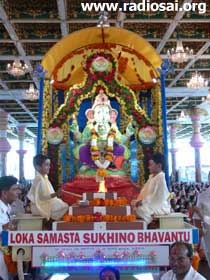









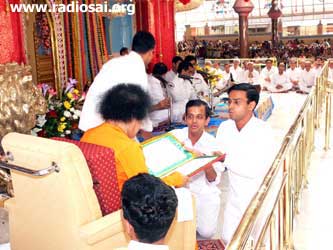


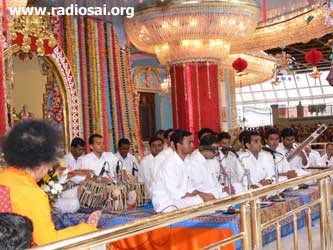

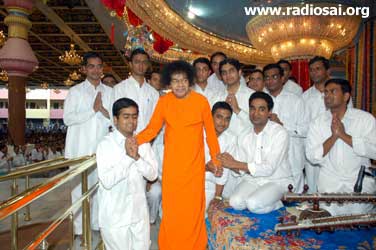


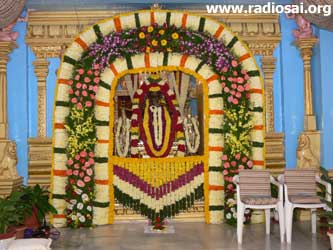







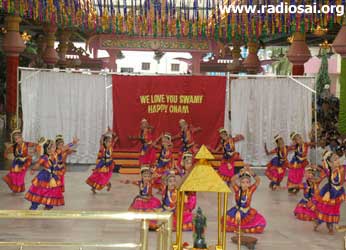
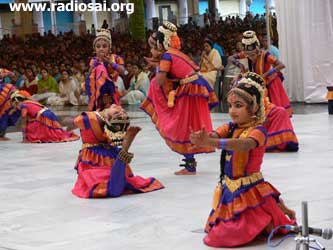
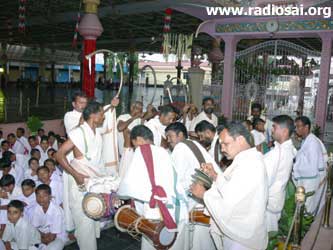

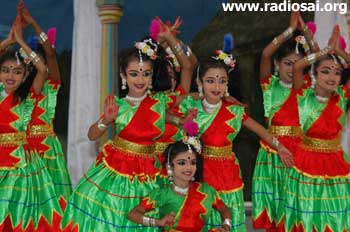
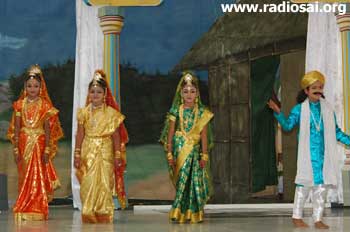
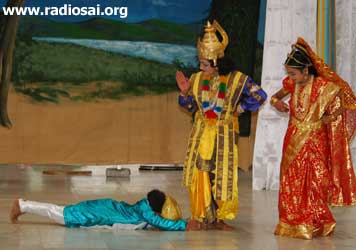

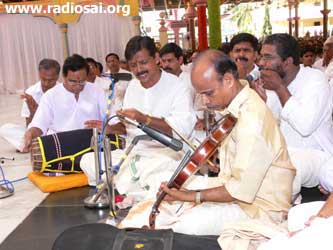

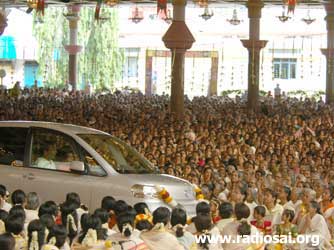

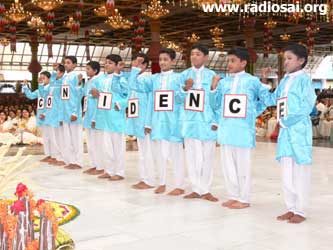
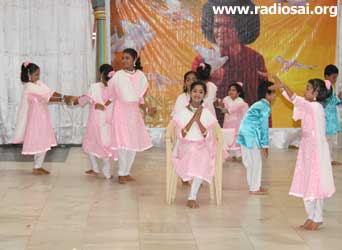
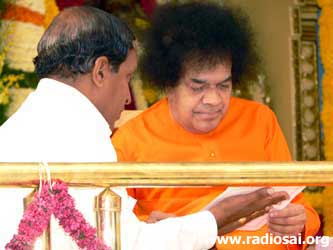
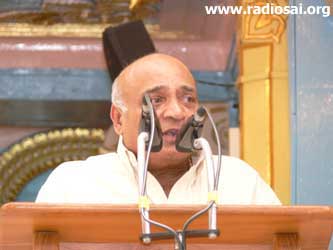

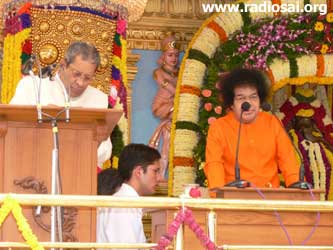
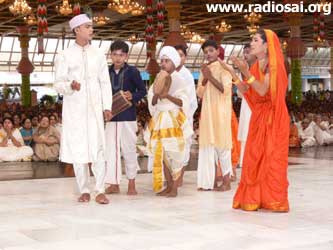
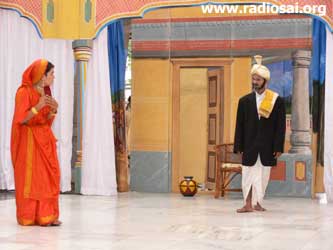
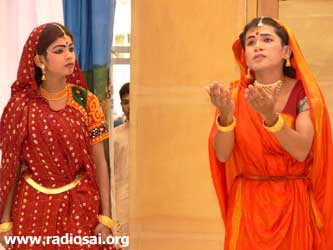
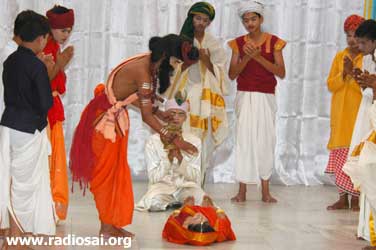
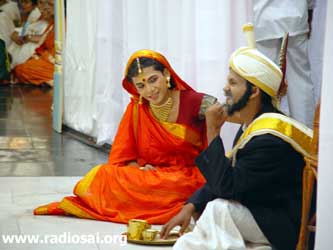
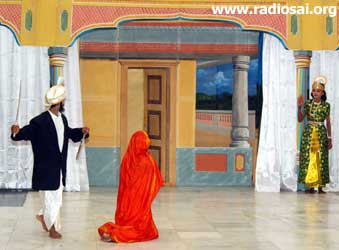

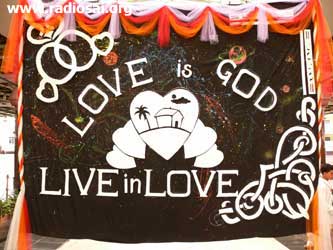
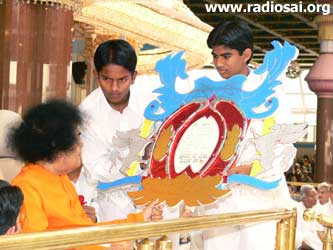
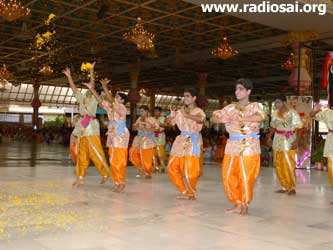
-with-Ka.jpg)
